- Bernard Preston homepage
- Beekeeping
- Beeswax Solar Extractor
Beeswax solar extractor
A beeswax solar extractor is not difficult to build but it does take a bit of planning; and some expense. The double-glazing is fairly costly. The rest can be made from workshop scraps.
Extracting beeswax from old combs and cappings is a fag; it regularly will boil over making an awful mess on the kitchen stove.
Eventually the honey, wax and beekeeper will be completely banished from the good wife's kitchen; a woman would probably do it better. Even so a solar extractor is a big step forwards; electricity is no longer cheap.
This was in fact Bernard Preston's first venture into using energy from the sun in his home, long before he considered heating water and generating electricity.
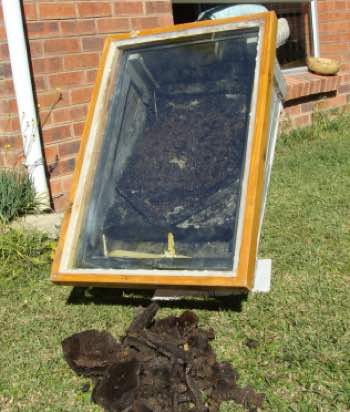
This page was last updated by Bernard Preston on 9th January, 2023.
Most of the extractors I have seen have a pipe leading out of the hot box but the problem is that on meeting the cold air, it tends to cool and solidify. So I made a double-chambered container with the molten wax remaining inside.
It is crude but effective; you must have a lid with double-glazing to trap sufficient heat from the sun.
Use light materials; mine is too heavy. I will give you the dimensions of this one but I would make it only 25cm wide if I constructed another; but long enough to hold a brood frame.
That is unless you have a large number of hives; then I would stay with these dimensions.
Normally I would use a small plastic container in the recess to capture the wax. Notice how clean it is with no filtering.
In the winter when the temperature is lower it is a golden-yellow colour but the wax I have just extracted in midsummer is much darker. Heat damages the products from the hive.
Beeswax solar extractor
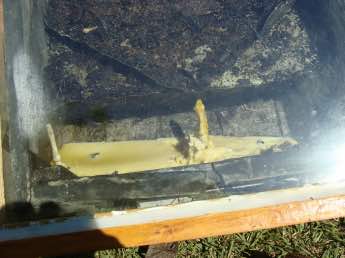
A beeswax solar extractor means no more overflows on the stove. It tends to boil and froth the moment you look the other way making a terrible mess.
This way you waste no electricity and it's not messy; it is so user-friendly. The good wife did me a great favour by banishing me and everything to do with honey and beeswax from her kitchen.
Start by building a box from old timbers that you may have lying around. Use wood no thicker than 15mm; otherwise it will be very heavy and hard on the back.
Mine is rectangular; 70cm long by 50 wide.
At the back it is 30cm deep and at the lower end 15. That was because originally it rested on the ground and needed a slope for the wax to gravitate to the second chamber.
Then I built a steel base years later, angling the whole contraption and making it easy to turn; so it no longer needs to be deeper at one end than the other.
Today I would make it 20cm deep at both ends, since it stands on a base making it easy to turn and follow the sun.
The base for your beeswax solar extractor needs to be quite sturdy; a solid round bar about 5cm long slots into the pipe. Do not use square tubing as I did, though it works well enough. A short piece of angle-iron strengthens the bottom.
I used fairly heavy 5mm plate; two pieces of scrap from the steel merchant, one screwed to the beeswax solar extractor base.
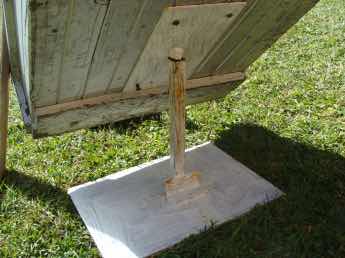
The angle is not critical though this is a fraction too steep; the sluggum and frames tend to slide down.
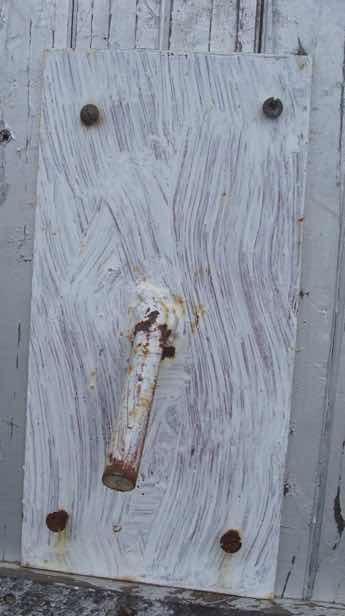
Extractor lid
The extractor lid must to be quite firm as the two sheets of 5mm glass are rather heavy. I used 20 x 60mm timber to make up the frame; its corners need to be exactly square.
This is Mark II; the first version which eventually rotted after twenty years I routed out the rebate for the glass on both sides. That was unnecessarily difficult.
For the second lid I simply cut a small strip of wood 10 x 20cm which I glued and nailed to the inside of the frame; the glass panes nestle on either side of it in a bed of silicone.
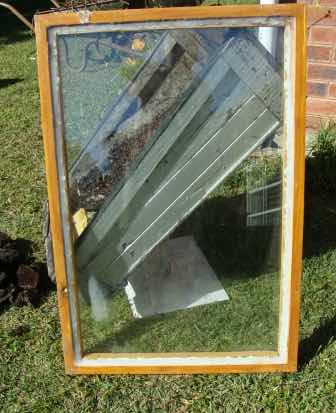
Drill a small hole through the wooden frame on the lower edge so that it enters the space between the panes. The temperature of the air in that enclosed area gets very high; the increased pressure actually shattered the 5mm glass on Mark I.
Cover the hole with a piece of insulation tape to stop water getting in; but allowing excess pressure out.
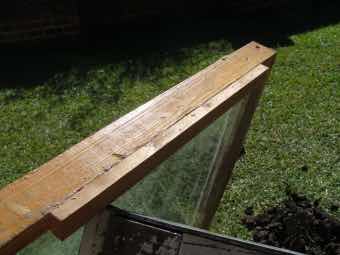
Glue a strip of scrap wood onto the frame to stop it from sliding off.
Extractor box
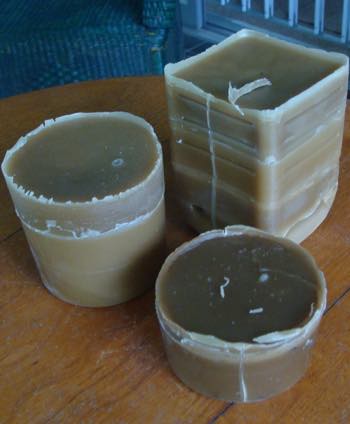
So make a sturdy rectangular extractor box, 200mm deep, 70cm long and 25 wide. Fit a sturdy bottom.
Build a raised area about 5cm deep leaving the recess into which the molten wax will drip; actually into a plastic dish.
Line the floor of the upper chamber with discarded aluminium sheets from a printing company; then make a sort of funnel out of the same material. As the wax melts it runs downwards by gravity, through the crude narrows and into the plastic container in the recess below.
Line the upper edge of the box with a heavy-duty rubber strip; the glass must sit firmly keeping the hot air in.
This solar extractor works extremely well in our mild winters; to the apiarist wax is even more valuable than honey.
Then I send the raw wax to a rolling company who return the foundation for use in the hives next season.
I cheat a little and drip candle wax onto the sheet to make sure it's firm and does not come loose.
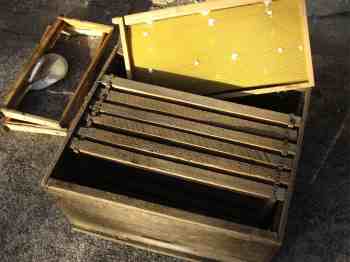
Raw honey
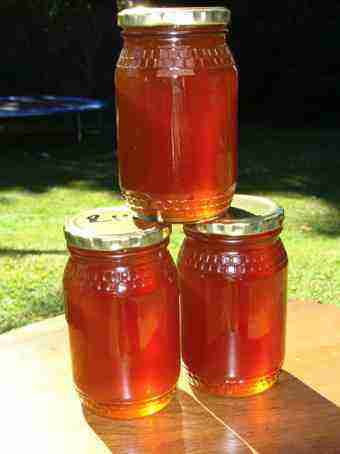
Whilst the drippings from your beeswax solar extractor can be used for a whole variety of skin conditions and other products, for most of us it is all about raw honey.
Only the privileged few unfortunately can enjoy raw, unprocessed honey; beekeepers and those who go out of their way to locate a local apiarist.
Sadly most from the supermarket today has been spoiled by processing, over-refining and adulteration with synthetic sugars. I'm not convinced that it is of much more value than sucrose for sweetening. It has a very high glycemic index compared to natural honey which astonishingly has a low GI[4].
By using only coarse filters the pollen allowed through into the liquid lowers the GI further. Surprisingly the raw honey glycemic index is not high, despite the simple sugars; still it should only be used in moderation. I enjoy no more than perhaps two or three teaspoons a day; 6g of net carbs/tsp.
Absolutely avoid all artificial sweeteners; chemicals like Saccharin produce glucose intolerance just like sugar and refined starches do.
Natural honeycomb incidentally is one of very few proven treatments for non-alcoholic fatty liver, an oft fatal disease.
And finally crystallised and creamed honey are not the same; we now routinely paddle all of ours for a few minutes, seeding it with some left over from last year.
Bernard Preston
Bernard Preston is a semi-retired DC, cum hobbyist keeper. He made this beeswax solar extractor when he was driven from his wife's kitchen because of the mess made when it boiled over on her stove.
Hell hath no fury like a woman whose kitchen has been repeatedly messed.
When browsing use right click and "Open Link in New Tab" or you may get a bad gateway signal.
Newsletter
Our newsletter is entitled "create a cyan zone" at your home, preserving both yourself and Mother Earth for future generations; and the family too, of course. We promise not to spam you with daily emails promoting various products. You may get an occasional nudge to buy one of my books.
Here are the back issues.
- Lifestyle and ideal body weight
- What are ultra-processed foods?
- Investing in long-term health
- Diseases from plastic exposure
- Intensive lifestyle management for obesity has limited value
- A world largely devoid of Parkinson's Disease
- The impact of friendly bacteria in the tum on the prevention of cancer
- There's a hole in the bucket
- Everyone is talking about weight loss drugs
- Pull the sweet tooth
- If you suffer from heartburn plant a susu
- Refined maize meal and stunting
- Should agriculture and industry get priority for water and electricity?
- Nature is calling
- Mill your own flour
- Bake your own sourdough bread
- Microplastics from our water
- Alternative types of water storage
- Wear your clothes out
- Comfort foods
- Create a bee-friendly environment
- Go to bed slightly hungry
- Keep bees
- Blue zone folk are religious
- Reduce plastic waste
- Family is important
- What can go in compost?
- Grow broad beans for longevity
- Harvest and store sunshine
- Blue zone exercise
- Harvest and store your rainwater
- Create a cyan zone at your home
Did you find this page interesting? How about forwarding it to a friendly book or food junkie? Better still, a social media tick would help.
- Bernard Preston homepage
- Beekeeping
- Beeswax Solar Extractor
Address:
56 Groenekloof Rd,
Hilton, KZN
South Africa
Website:
https://www.bernard-preston.com